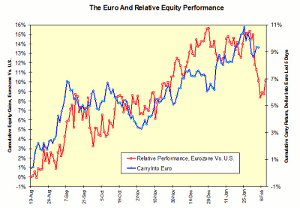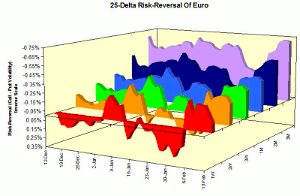At least two market indicators suggest that the path of least resistance for the euro is for it to weaken against the dollar, says Howard Simons on Minyanville.com.
About 20 years ago, a broker friend remarked about gold, "You can have one client long and one client short, and they are both unhappy." The brain trust at the European Central Bank must feel the same way about its member states and their common currency: Regardless of whether the currency is threatened with extinction, as it has seemed to be on numerous occasions since late 2009, or whether it is rebounding smartly and making exporters squirm, someone is unhappy at all times.
The same situation applies for national currencies and has done so for the past 40 years of the floating exchange-rate era: Someone somewhere is unhappy and is determined to override the market's judgment. In circularity, the market's judgment, especially for the more heavily managed currencies such as the Japanese yen, is often little more than guessing the official manipulators' intentions, but I digress.
Pointing Lower
At least two market indicators suggest
that the path of least resistance for the euro is for it to weaken
against the dollar; whether this is equivalent to saying that the ECB is
joining the competitive devaluation game is open for discussion. The first
indicator is the relative performance of Eurozone stocks in USD terms as
measured by the MSCI Barra index relative to their US counterparts. This measure
has been leading the carry return of the dollar into the euro, effectively the
same thing as a continuous futures contract on the euro, over the past six
months.
As for the second indicator, look at the options market's risk-reversal map at 25-delta positions. This is the difference between the volatility for out-of-the-money call and put options on the euro. The more negative the risk-reversal is, the more the options market is betting on a weaker euro. Please note that I have plotted these inversely from expirations going from one week out to three months; the longer the maturity, the more negative the risk-reversal.
Currencies have a way of negating the returns you think you are making in a foreign market. For example, the MSCI Barra index for Japan has gained 30.8% in yen terms since the yen's downside breakout began in November 2012. In USD terms, returns shrink to 14.0%, which is not much better than the 13.2% gain for the US over the same period. If we repeat the trick for the Eurozone, a euro-denominated gain of 9.7% expands to 15.5%.
If you are muttering to yourself, "International diversification sounds like an expensive way of trading currencies," you would be correct even though people next to you might wonder why you are muttering at the screen. Conversely, trading currencies can be viewed as a cheap way of gaining or shedding international equity exposure. I would daresay, however, my long-ago broker friend would tell me it was a lot easier to get investors interested in international equity ETFs-such the iShares MSCI Japan Fund (EWJ) or the Vanguard MSCI European ETF (VGK)—than to get them to start trading currencies.
Howard Simons, Contributor, Minyanville.com



















